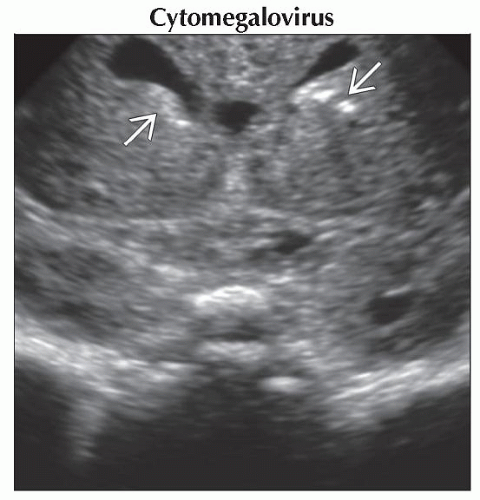Intracranial Calcifications
Paula J. Woodward, MD
DIFFERENTIAL DIAGNOSIS
Common
-
Maternal Infection
-
Cytomegalovirus
-
Toxoplasmosis
-
Varicella
-
Rare but Important
-
Teratoma
ESSENTIAL INFORMATION
Key Differential Diagnosis Issues
-
Significant overlap in imaging findings of in utero infections
-
Intrahepatic and intracranial calcifications most common findings
-
Intracranial calcifications may be non-shadowing and subtle
-
-
Requires maternal/fetal serologies to make definitive diagnosis
Helpful Clues for Common Diagnoses
-
Cytomegalovirus
-
Most common congenital infection
-
Main reservoir is children under < 2 years
-
Brain most commonly affected area
-
Calcifications (predominately periventricular), ventriculomegaly, microcephaly
-
-
Other findings include intrauterine growth restriction (IUGR), hepatosplenomegaly, cardiomyopathy, echogenic bowel and hydrops
-
-
Toxoplasmosis
-
Cats are definitive hosts: Oocyst shed in feces
-
Human infection from contaminated soil, water, undercooked meats
-
Non-shadowing intracranial and intrahepatic calcifications
-
Intracranial calcifications may be periventricular or random in distribution
-
Other findings include ventriculomegaly, IUGR and echogenic bowel
-
-
Varicella
-
Transplacental infection of fetus following maternal chickenpox infection
-
Intrahepatic and intracranial calcifications
-
May also see liver, heart, renal calcifications
-
-
Polyhydramnios due to neurologic impairment of swallowing
-
Limb hypoplasia and contractures
-
Paradoxical diaphragmatic motion on real time sonography due to unilateral paralysis
-
Cutaneous lesions in dermatomal distribution seen in neonate
-
Helpful Clues for Rare Diagnoses
-
Teratoma
-
Most common brain tumor in fetus
-
Obvious, large, destructive mass with cystic and solid components
-
Calcification most specific feature but not always present
-
Image Gallery

Coronal ultrasound focused on the frontal horns shows periventricular calcifications
 . Only minimal shadowing is seen, which is typical. . Only minimal shadowing is seen, which is typical.Stay updated, free articles. Join our Telegram channel
Full access? Get Clinical Tree
 Get Clinical Tree app for offline access
Get Clinical Tree app for offline access

|